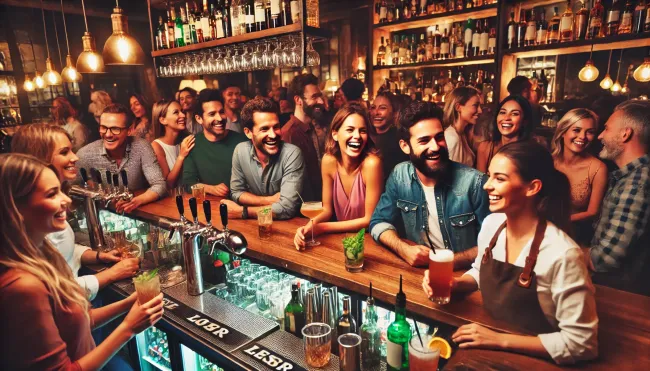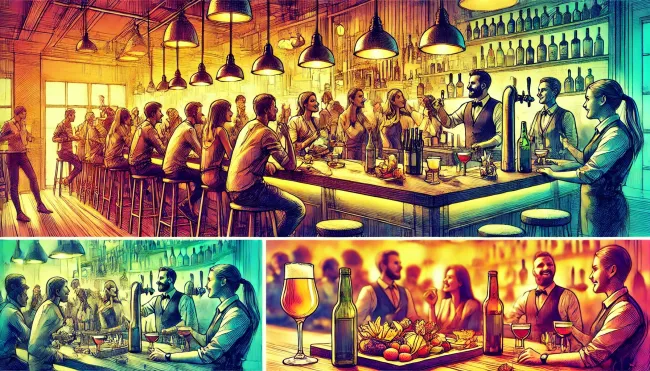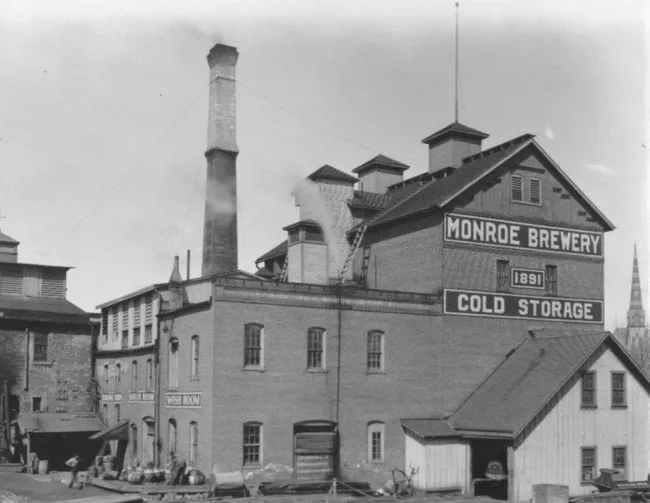Happy hour specials have long been a popular promotional tactic in the hospitality industry. For many bars and restaurants, happy hour represents more than just a few discounted drinks and appetizers; it can be a powerful strategy to boost sales, attract new customers, and foster a loyal community of patrons. This article explores the real impact of happy hour on local businesses and offers insights for bar and restaurant managers who might be debating whether to implement or enhance their own happy hour offerings.

A lively bar scene during happy hour, featuring a wide shot of a bustling bar with people socializing, enjoying drinks, and engaging with the bartender. Image generated by ChatGPT using DALL·E by OpenAI.
The Benefits of Happy Hour: Increased Foot Traffic and Sales
One of the most significant benefits of offering a happy hour is the ability to attract more customers during off-peak hours. Typically held in the late afternoon or early evening, happy hour specials are designed to draw people into a bar or restaurant at times when business might otherwise be slow. By offering discounts on popular drinks and appetizers, establishments can significantly increase foot traffic, turning a quiet period into a bustling, lively atmosphere.
Research shows that these increased numbers translate directly into boosted sales. A study published in the Journal of Hospitality & Tourism Research found that happy hour promotions effectively drive higher sales volumes, even if the profit margin per item is reduced due to discounts (Levy & Duan, 2020). The logic is simple: more customers mean more sales. Moreover, customers who come in for happy hour deals often end up purchasing full-priced items as well, such as entrees or premium drinks, further contributing to overall revenue.
Customer Retention and Loyalty: Building a Community
Beyond the immediate financial benefits, happy hour specials can also play a crucial role in building customer retention and loyalty. By providing a regular event that customers can look forward to, bars and restaurants create a sense of community and habit among patrons. This is especially true when happy hours are held consistently at the same time each week, allowing customers to plan their visits and make it a part of their routine.
Additionally, many establishments use happy hour as an opportunity to showcase their unique offerings and ambiance, distinguishing themselves from competitors. For example, a bar that offers a selection of locally brewed craft beers at a discount during happy hour can attract beer enthusiasts and build a reputation as a go-to spot for craft beer lovers. Themed happy hours or special events, such as trivia nights or live music, can further enhance this sense of community and make customers more likely to return.
Marketing and Brand Awareness: Attracting New Customers
Happy hours also serve as an effective marketing tool, helping bars and restaurants attract new customers who might not have visited otherwise. Promotions are often advertised through social media, local event listings, or even word-of-mouth, reaching a wide audience and driving awareness of the establishment. This can be particularly beneficial for new or lesser-known businesses looking to establish themselves in a competitive market.
In some cases, happy hour specials can even shape an establishment's brand and identity. A bar that consistently offers a lively happy hour with DJ music and dancing may become known as a party spot, while a restaurant that focuses on high-quality appetizers and specialty cocktails during happy hour might be seen as a more upscale, sophisticated destination. By aligning happy hour offerings with the preferences and behaviors of the local customer base, businesses can effectively position themselves in the market and attract a targeted demographic.
Evidence and Case Studies: Real-World Insights
The positive impact of happy hour on local businesses is not just theoretical; it is backed by evidence from real-world case studies and industry reports. Many bar and restaurant owners have reported significant benefits from implementing happy hour promotions, particularly in terms of increased patronage and sales.
For example, a study in the International Journal of Hospitality Management examined customer spending patterns during happy hour events and found that while the average spend per customer might decrease due to discounted prices, the overall revenue tends to increase due to a higher volume of customers and additional purchases (Liu & Tse, 2018). This finding aligns with the experiences of many local business owners who have seen their establishments transform from quiet venues into bustling hotspots during happy hour.
Furthermore, a report by Technomic, a leading food service research firm, highlights the effectiveness of happy hour promotions in driving incremental sales, particularly in casual dining and bar settings. The report notes that happy hour can be a powerful tool for filling tables during slow periods, attracting new patrons, and encouraging repeat visits (Technomic, 2022).
Implementing a Successful Happy Hour: Tips for Bar and Restaurant Managers
For bar and restaurant managers considering implementing or enhancing their happy hour specials, there are several key factors to keep in mind to maximize the potential benefits:
- Know Your Audience: Understanding the preferences and behaviors of your target customers is crucial. Tailor your happy hour offerings to meet their tastes and needs, whether that means offering discounts on craft beers, cocktails, appetizers, or all of the above.
- Timing Is Everything: Choose a time for your happy hour that aligns with your business’s slow periods. Many establishments find success with happy hours held in the late afternoon or early evening, but it’s essential to analyze your customer flow and adjust accordingly.
- Promote Effectively: Use social media, local listings, and even in-house signage to promote your happy hour specials. Engaging visuals and clear messaging can help attract attention and drive foot traffic.
- Create a Welcoming Atmosphere: Happy hour is not just about discounts; it’s also about creating a fun, inviting environment. Consider adding live music, hosting themed events, or offering games and activities to enhance the experience and encourage customers to stay longer.
- Monitor and Adjust: Track the performance of your happy hour specials to see what’s working and what’s not. Don’t be afraid to experiment with different promotions, pricing, and event formats to find the best fit for your establishment.
Conclusion: The Power of Happy Hour
In conclusion, happy hour specials can be a highly effective strategy for local bars and restaurants looking to boost sales, attract new customers, and build a loyal community of patrons. By understanding the benefits, analyzing real-world evidence, and implementing best practices, bar and restaurant managers can make informed decisions about how to leverage happy hour promotions to their advantage. Whether you’re looking to fill your venue during slow periods or create a buzz around your brand, happy hour could be the key to unlocking your business’s full potential.
By thoughtfully integrating happy hour into your business strategy, you can create a win-win scenario where customers enjoy great deals and experiences, while your establishment enjoys increased patronage, sales, and brand loyalty.
Article Sources
Levy, S. E., & Duan, W. (2020). The effects of happy hour promotion on consumer behavior and sales performance in the hospitality industry. Journal of Hospitality & Tourism Research, 44(3), 345-360. https://doi.org/10.1177/1096348019832724
Liu, P., & Tse, E. C. (2018). Impact of happy hour on restaurant revenue: A study on customer spending patterns. International Journal of Hospitality Management, 73, 75-84. https://doi.org/10.1016/j.ijhm.2018.01.002
National Restaurant Association. (2023). Restaurant industry factbook. National Restaurant Association. Retrieved from https://www.restaurant.org
Nielsen. (2022). Trends in alcoholic beverage consumption: Happy hour promotions. Nielsen. Retrieved from https://www.nielsen.com
Technomic. (2022). On-premise intelligence report. Technomic. Retrieved from https://www.technomic.com
Thomé, K. M., & Filimonau, V. (2019). Price promotions and their effect on restaurant financial performance: The case of happy hours. Cornell Hospitality Quarterly, 60(2), 122-135. https://doi.org/10.1177/1938965519828406



